BUICK REGAL 1998 Owners Manual
Manufacturer: BUICK, Model Year: 1998, Model line: REGAL, Model: BUICK REGAL 1998Pages: 388, PDF Size: 20.19 MB
Page 231 of 388
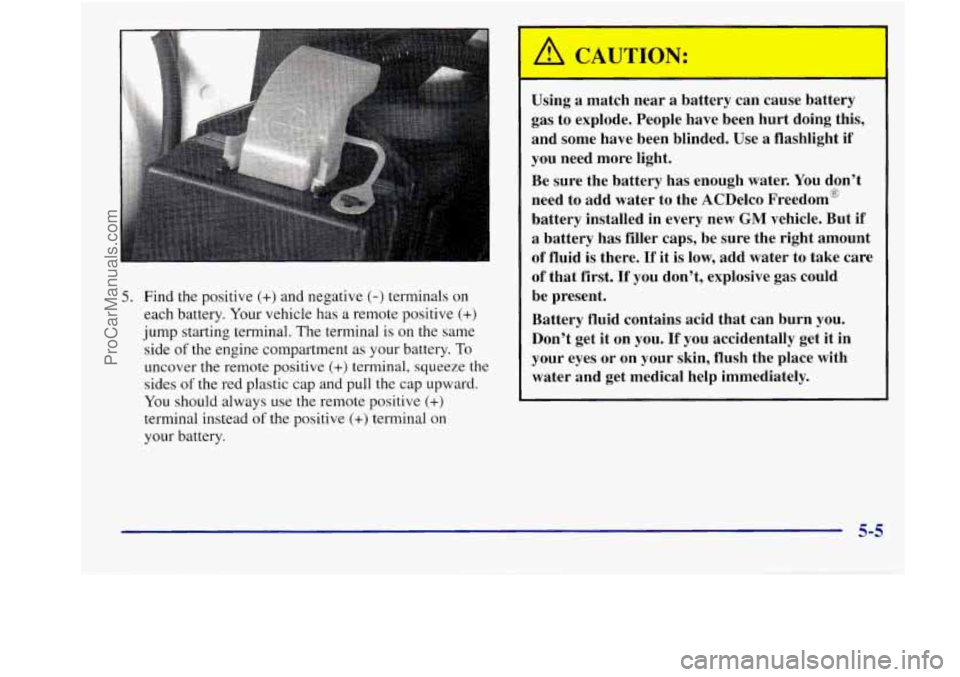
5. Find the positive (+) and negative (-) terminals on
each battery. Your vehicle has a remote positive (+)
jump starting terminal. The terminal is on the same
side
of the engine compartment as your battery. To
uncover the remote positive (+) terminal, squeeze the
sides
of the red plastic cap and pull the cap upward.
You should always use the remote positive
(+)
terminal instead of the positive (+) terminal on
your battery. Using
a match near
a battery can cause battery
gas to explode. People have been hurt doing this,
and some have been blinded.
Use a flashlight if
you need more light.
Be sure the battery has enough water. You don’t
need to add water to the ACDelco Freedom@
battery installed in every new
GM vehicle. But if
a battery has filler caps, be sure the right amount
of fluid is there. If it is low, add water to take care
of that first.
If you don’t, explosive gas could
be present.
Battery fluid contains acid that can burn you.
Don’t get it on you.
If you accidentally get it in
your eyes
or on your skin, flush the place with
water and get medical help immediately.
5-5
ProCarManuals.com
Page 232 of 388
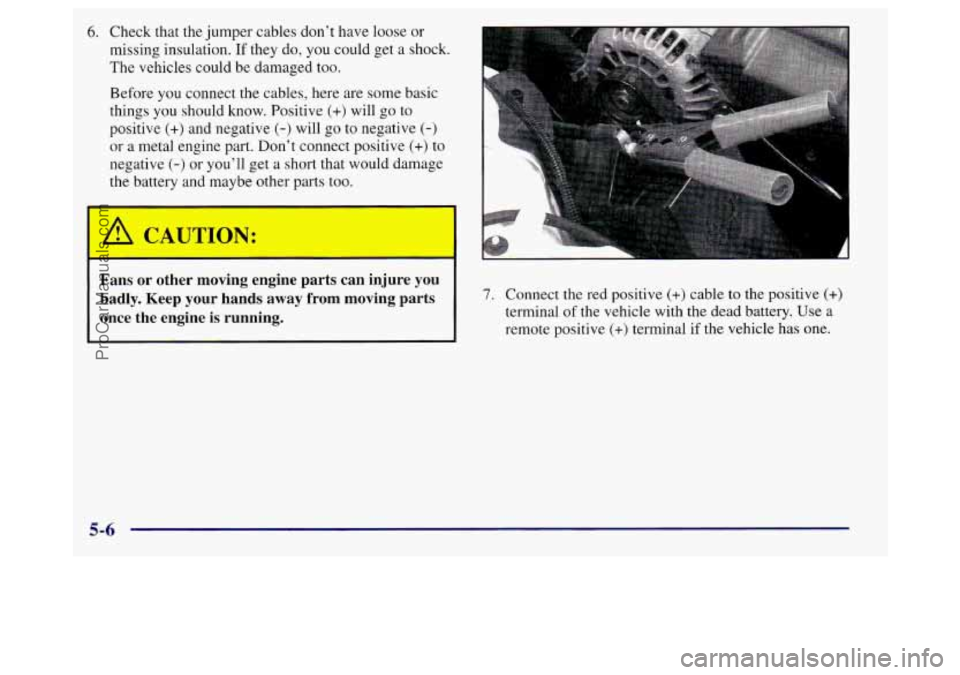
6. Check that the jumper cables don’t have loose or
missing insulation. If they do, you could get a shock.
The vehicles could be damaged too.
Before
you connect the cables, here are some basic
things you should know. Positive
(+) will go to
positive
(+) and negative (-) will go to negative (-)
or a metal engine part. Don’t connect positive (+) to
negative
(-) or you’ll get a short that would damage
the battery and maybe other parts too.
A CAUTION:
I
Fans or other moving engine parts can injure you
badly. Keep your hands away from moving parts
once the engine is running.
I
7. Connect the red positive (+) cable to the positive (+)
terminal of the vehicle with the dead battery. Use a
remote positive
(+) terminal if the vehicle has one.
5-6
ProCarManuals.com
Page 233 of 388
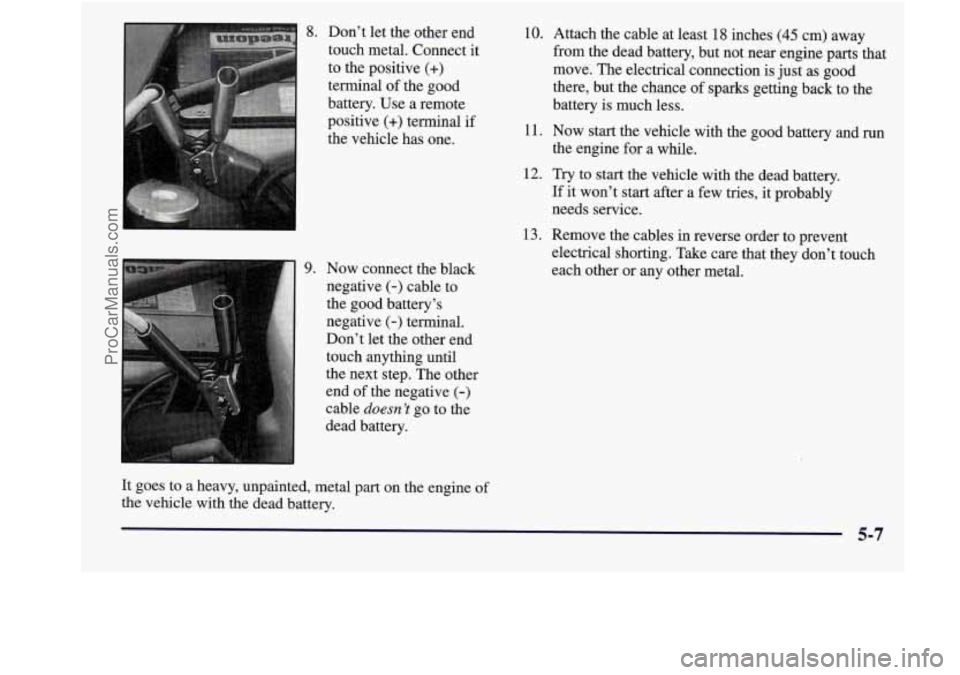
8. Don’t let the other end
touch metal. Connect
it
to the positive (+)
terminal of the good
battery. Use a remote
positive
(+) terminal if
the vehicle has one.
10. Attach the cable at least 18 inches (45 cm) away
from the dead battery, but not near engine parts that
move. The electrical connection
is just as good
there, but the chance of sparks getting back to the
battery is much less.
11. Now start the vehicle with the good battery and run
the engine for a while.
9. Now connect the black
negative
(-) cable to
negative
(-) terminal.
Don’t let the other end
touch anything until
the next step. The other
end of the negative
(-)
cable doesn t go to the
dead battery. the
good battery’s
12. Try to start the vehicle with the dead battery.
If it won’t start after a few tries, it probably
needs service.
13. Remove the cables in reverse order to prevent
electrical shorting. Take care that they don’t touch
each other or any other metal.
It goes to a heavy, unpainted, metal part
on the engine of
the vehicle with the dead battery.
ProCarManuals.com
Page 234 of 388
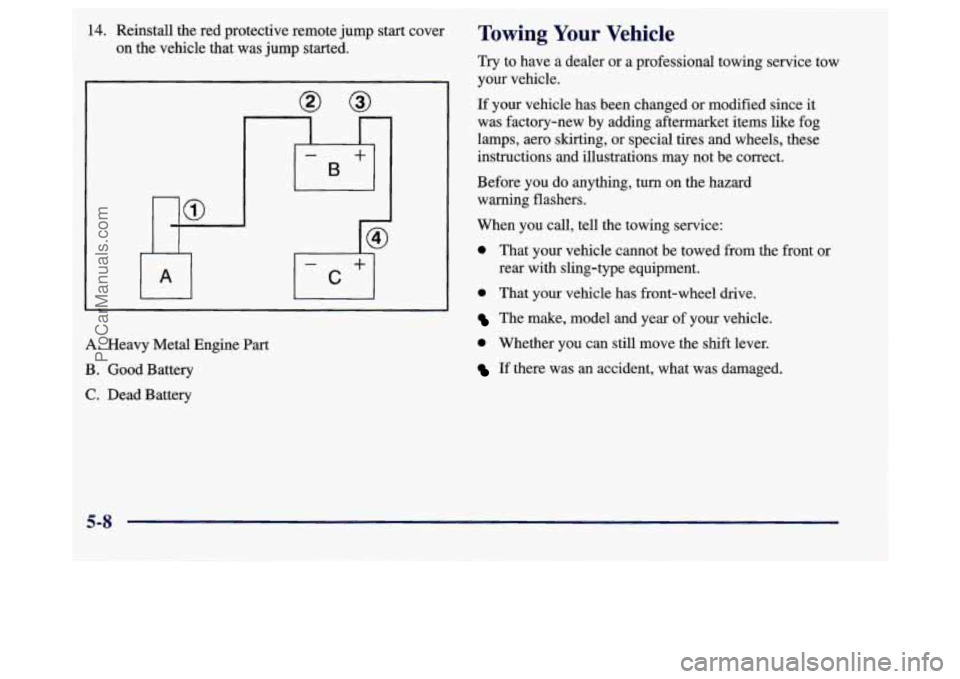
14. Reinstall the red protective remote jump start cover
on the vehicle that was jump started.
A. Heavy Metal Engine Part
B. Good Battery
C. Dead Battery
Towing Your Vehicle
Try to have a dealer or a professional towing service tow
your vehicle.
If your vehicle has been changed or modified since it
was factory-new by adding aftermarket items like fog
lamps, aero skirting, or special tires and wheels, these
instructions and illustrations may not be correct.
Before you do anything, turn on the hazard
warning flashers.
When you call, tell the towing service:
0 That your vehicle cannot be towed from the front or
rear with sling-type equipment.
0 That your vehicle has front-wheel drive.
The make, model and year of your vehicle.
0 Whether you can still move the shift lever.
If there was an accident, what was damaged.
5-8
ProCarManuals.com
Page 235 of 388
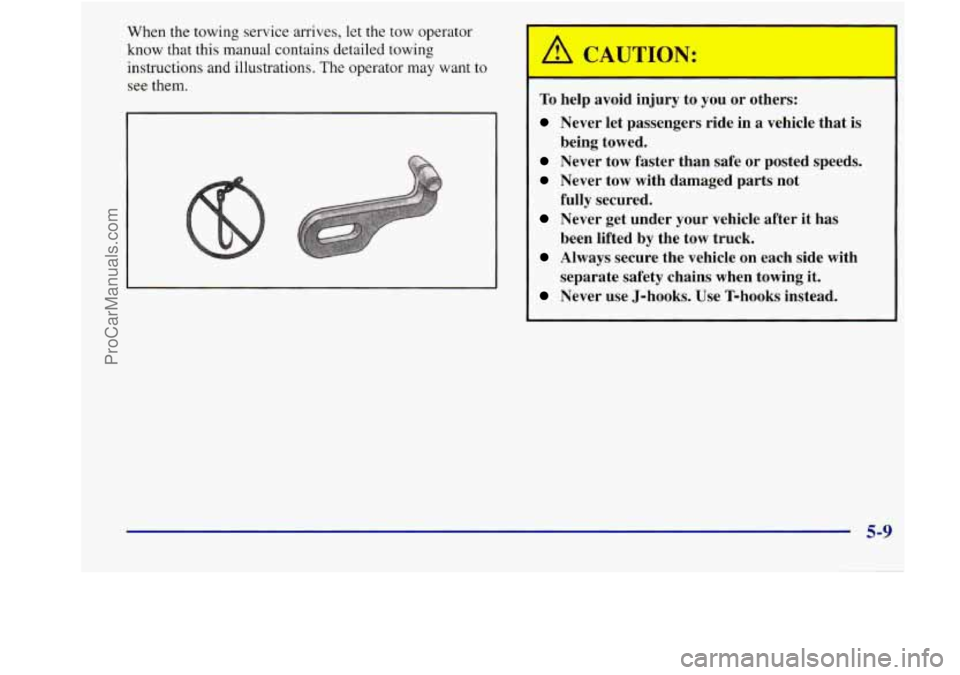
When the towing service arrives, let the tow operator
know that this manual contains detailed towing
instructions and illustrations. The operator may want to
see them.
To help avoid inj y to you or others:
Never let passengers ride in a vehicle that is
Never tow faster than safe or posted speeds.
Never tow with damaged parts not
fully secured.
Never get under your vehicle after it has
been lifted by the tow truck.
Always secure the vehicle on each side with
separate safety chains when towing it.
Never use J-hooks. Use T-hooks instead.
being
towed.
5-9
ProCarManuals.com
Page 236 of 388
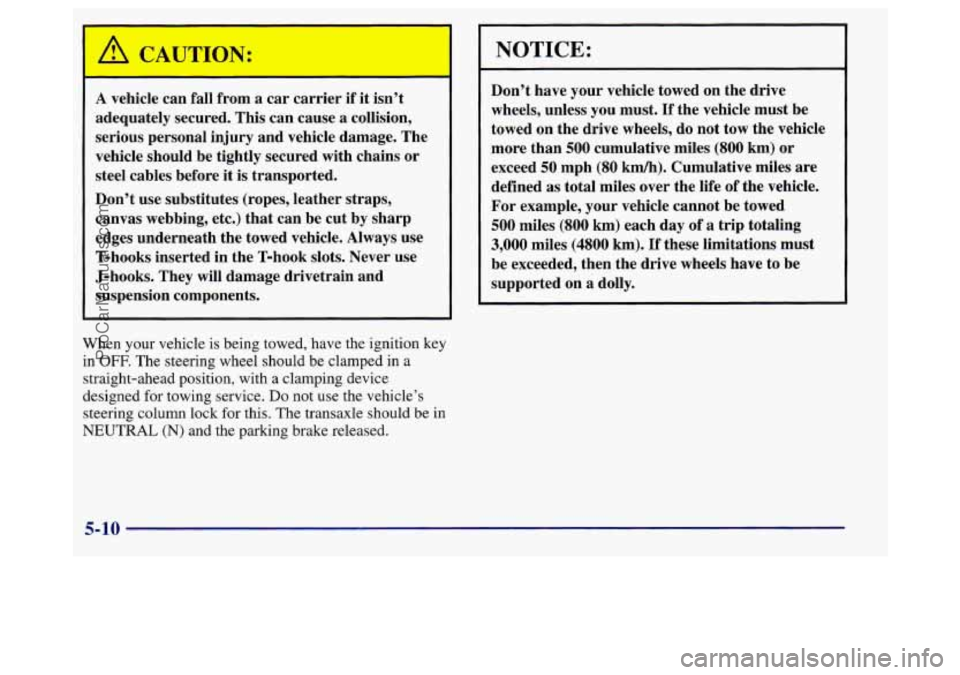
A vehicle can fall from a car carrier if it isn’t
adequately secured. This can cause
a collision,
serious personal injury and vehicle damage. The
vehicle should be tightly secured with chains or
steel cables before
it is transported,
Don’t use substitutes (ropes, leather straps,
canvas webbing, etc.) that can be cut by sharp
edges underneath the towed vehicle. Always use
T-hooks inserted in the T-hook slots. Never use
J-hooks. They will damage drivetrain and
suspension components.
When your vehicle is being towed, have the ignition key
in OFF. The steering wheel should be clamped in a
straight-ahead position, with a clamping device
designed for towing service.
Do not use the vehicle’s
steering column lock for this. The transaxle should be
in
NEUTRAL (N) and the parking brake released.
NOTICE:
Don’t have your vehicle towed on the drive
wheels, unless you must,
If the vehicle must be
towed on the drive wheels, do not tow the vehicle
more than
500 cumulative miles (800 km) or
exceed
50 mph (80 km/h). Cumulative miles are
defined
as total miles over the life of the vehicle.
For example, your vehicle cannot be towed
500 miles (800 km) each day of a trip totaling
3,000 miles (4800 km). If these limitations must
be exceeded, then the drive wheels have to be
supported on
a dolly.
5-10
ProCarManuals.com
Page 237 of 388
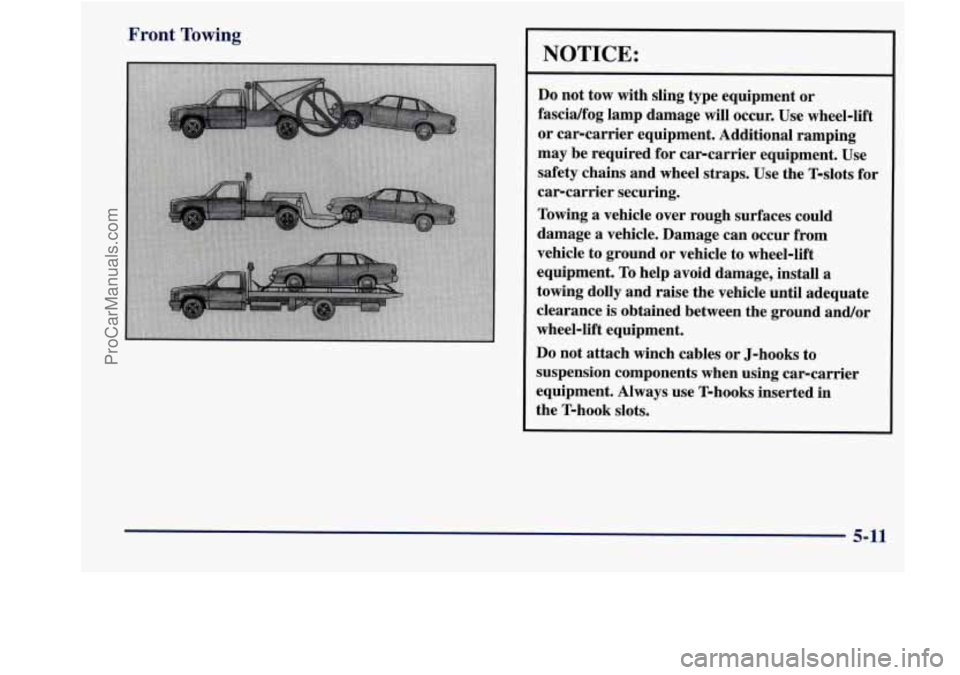
Front Towing
NOTICE:
Do not tow with sling type equipment or
fascidfog lamp damage will occur. Use wheel-lift
or car-carrier equipment. Additional ramping
may be required for car-carrier equipment. Use
safety chains and wheel straps. Use the T-slots for
car-carrier securing.
Towing a vehicle over rough surfaces could
damage a vehicle. Damage can occur from
vehicle to ground or vehicle to wheel-lift
equipment. To help avoid damage, install a
towing dolly and raise the vehicle until adequate
clearance
is obtained between the ground and/or
wheel-lift equipment.
Do not attach winch cables or J-hooks to
suspension components when using car-carrier
equipment. Always use T-hooks inserted in
the T-hook slots.
5-11
ProCarManuals.com
Page 238 of 388
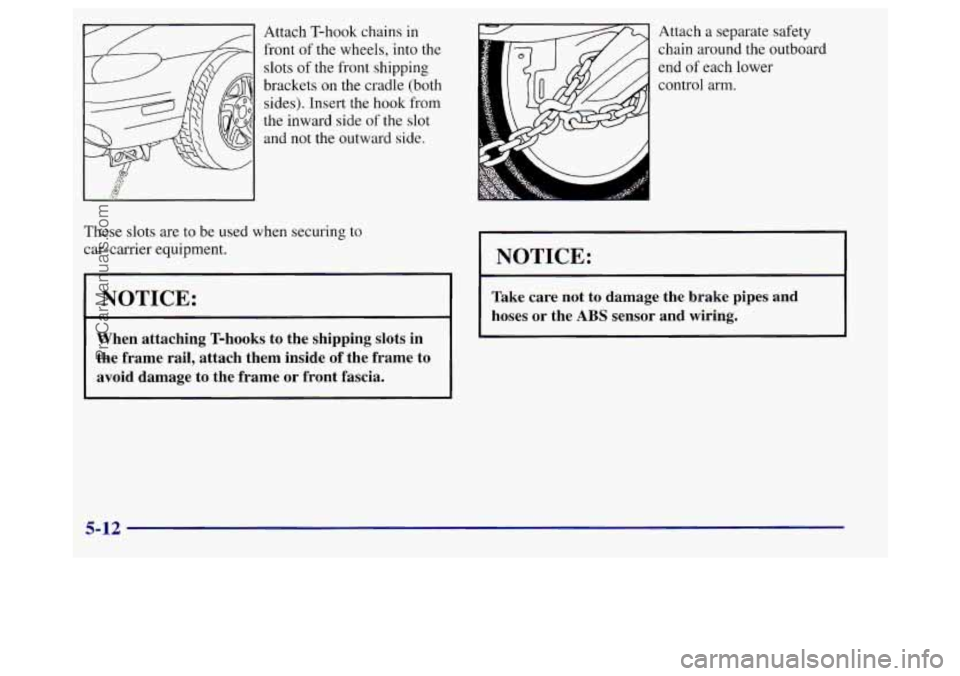
Attach T-hook chains in
front of the wheels, into the
slots
of the front shipping
brackets on the cradle (both
sides). Insert the hook from
the inward side of the slot
and not the outward side.
These slots are
to be used when securing to
car-carrier equipment.
NOTICE:
When attaching T-hooks to the shipping slots in
the frame rail, attach them inside of the frame to
avoid damage to the frame or front fascia.
Attach a separate safety
chain around the outboard
end
of each lower
control arm.
I NOTICE:
I
Take care not to damage the brake pipes and
hoses or the
ABS sensor and wiring. I
5-12
ProCarManuals.com
Page 239 of 388

Rear Towing
INOTICE:
Using a towing dolly for your drive wheels is
recommended if your vehicle is towed more
than
500 cumulative miles (800 km) or exceeds
50 mph (80 km/h).
NOTICE:
Do not tow with sling-type equipment or the rear
bumper valance will be damaged.
Use wheel-lift
or car-carrier equipment. Additional ramping
may be required for car-carrier equipment. Use
safety chains and wheel straps. Use the T-slots for
car-carrier securing.
Towing a vehicle over rough surfaces could
damage a vehicle. Damage can occur from
vehicle to ground or vehicle to wheel-lift
equipment.
To help avoid damage, install a
towing dolly and raise the vehicle until adequate
clearance is obtained between the ground and/or
wheel-lift equipment.
Do not attach winch cables or J-nooks to
suspension components when using car-carrier
equipment.
Always use T-hooks inserted in
T-hooks slots.
5-13
ProCarManuals.com
Page 240 of 388
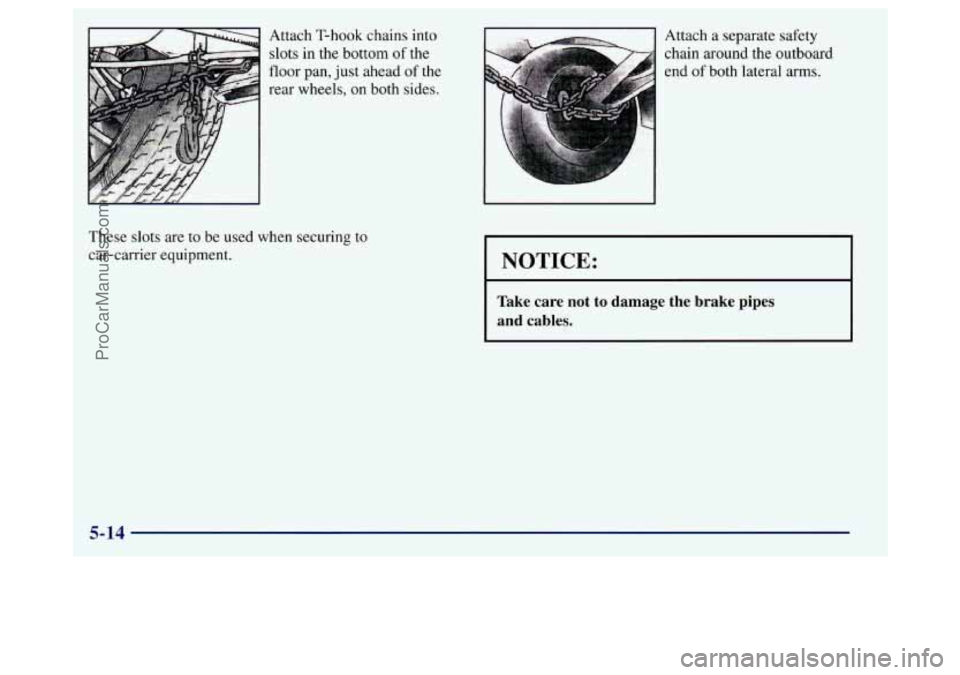
Attach T-hook chains into
slots
in the bottom of the
floor pan, just ahead of the
rear wheels, on both sides.
These slots are to be used when securing to
car-carrier equipment. Attach a
separate safety
chain around the outboard
end of both lateral arms.
I NOTICE:
Take care not to damage the brake pipes
and cables.
5-14
ProCarManuals.com